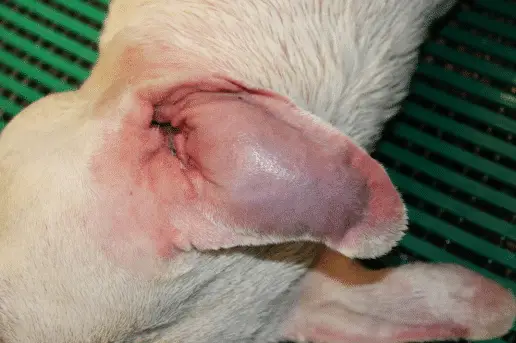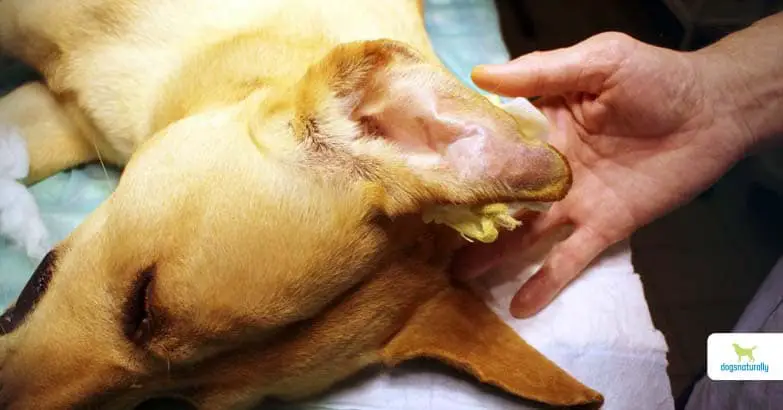Dog’s Ear Hematoma- Here’s All You Need To Know!
A dog’s ear hematoma is a condition in which a pool of blood from outside the blood vessels is usually found beneath the skin. An ear hematoma is sometimes referred to as aural hematoma. An ear hematoma is known to be extremely painful for your dog. Intense swelling as a result of the dog’s ear hematoma is alarming.
When not treated in time, the dog’s ear hematoma will heal on its own, but it takes weeks to heal, and till then, the discomfort becomes unbearable and painful.
Here’s all you need to know about a dog’s ear hematoma condition and how you can get it treated.
Dog’s Ear Hematoma

Dog’s ear hematoma, also attributed to as an aural or auricular hematoma, is a restricted pool of blood enclosed inside the dog’s ear flap. A hematoma typically happens in one ear flap but may occur in both dogs’ ears with inflammation throughout the complete or partial ear flap.
Signs and symptoms of dog’s ear hematoma
One of the usual or common indications of an ear hematoma is the dog is the appearance of a dog’s ear. Due to the lump or fluid-filled sac, the ear might seem bigger or thicker in size, showing on an exaggerated look, sometimes also referred to as cauliflower ear. The inflammation can be sensed firm to the touch or fluctuant and soft.
Here are the signs you should look for:
- Complete ear or a small part of the ear flap gets filled with the fluid.
- ear scratching
- Itching
- Hrad shaking
- Tilting of the head to the sides.
These signs not only indicate that your dog might have acquired an aural hematoma – but they might also mean that there is another underlying ailment leading to the hematoma that requires to be diagnosed early and treated.
If the dog displays any of these signs, it must immediately be monitored for more information on the cause. This disease is excruciating, so you will need to find the best way to treat your dog instantly.
Dog’s ear hematoma- Causes

Dog’s ear hematoma can be caused by multiple reasons such as aggressive head-scratching and shaking. The tissue inside the ear flap, also called the pinna, is pretty thin, and when it gets injured, the blood vessels may rupture. The area between the skin and ear cartilage fills up with fluid and blood, leading the ear to expand or swell very quickly and developing a balloon-like bud on your dog’s ear.
All breeds of dogs can grow ear hematomas, but species with larger ear flaps are highly susceptible due to the ear flaps slapping against the skull when the dogs shake their head aggressively.
What triggers the head-scratching typically or shaking in dogs, which in turn results in the hematoma formation? Several underlying diseases might be the reason behind dog’s ear hematoma, including:
- Ear mites.
- Any trauma to the pinna, such as a bite
- Skin diseases
- Immune disorders
- Allergies
- Blood-clotting disorders
- Bacterial infection or yeast infection
The majority of ear hematomas or aural hematomas occur by infection and allergies.
Diagnosis of dog’s ear hematoma
The dog’s ear hematoma can be identified and not complicated for a vet to determine by visual inspection. What is more crucial when preparing treatment is knowing the reason behind the hematoma formation in the first place.
The vet takes physical examinations to determine the leading cause of hematoma in dogs. Primary evaluation might involve, but is not restricted to, the given tests:
- Needle aspiration test- This test will verify that the fluid accumulated inside the pocket is blood.
- Routine blood work will be needed.
- Vets will order a urine test.
- Examination of the ear canal by the doctors to monitor for symptoms of infection. Foreign substances stuck inside the ear canal and parasites will be observed. This test will involve taking a small swab from the ear canal and examining it under the microscope to check bacteria or yeast (cytology or cells study).
- Food trials and skin tests to diagnose food or other sensitivities that may cause pain and discomfort. That could be more complicated than simply checking samples under the microscope; A few trial and error methods might be needed to recognize the allergen. The vet might conduct further allergy testing for diagnosis.
Treatment

A dog’s ear hematoma is highly painful for your dog, so it is crucial to have it checked as soon as you can.
There is constantly a chance that a bit of hematoma may not need to be continuously treated; they may heal on their own as the accumulated blood becomes absorbed again. But hematomas must still be examined out. Even a minor hematoma could be highly painful. While the inflammation will ultimately subside, the ear might permanently seem thicker and acquire a cauliflower appearance in the place where the hematoma was found.
For treating the hematoma, the veterinarian will most likely attempt to manage the underlying reason first, to check the occurrence of another hematoma developing on the opposite or same ear.
Many vets will suggest traditional remedies such as using at-home heated compresses, anti-inflammatory medications, or other discomfort medications for relief. But other treatments involve the following:
Needle aspiration: This is a simple and comparatively low-priced treatment that injects a thin needle inside the hematoma to empty the fluid. Steroids might be injected inside the ear to decrease inflammation, pain, and itchiness, with some medicine to fight any infection. The same method will be performed again a week later.
Placing a drain within the ear: In larger dog breeds, installing a drain within the ear flap might be a good choice if the ear is big enough to hold the gutter and the dog is ready to bear it. This approach lets the fluid drain for a week or more continuously instead of allowing it to fill up again immediately, as usually occurs with needle aspiration. However, such drains are rarely employed to cure hematomas.
Surgery: Surgery necessitates general anesthesia to be carried out. An incision is performed in the injured ear to empty the fluid and blood coagulation within the ear flap. Next, the vet will stitch two cartilage layers in the ear flap such that a small incision will remain open for draining the blood and fluid. This cut will ultimately heal on its own.
For dogs with more prominent ears, you might need the ear to secure to the head using a bandage to guard the blood vessels inside the event of head-scratching or head-shaking throughout recovery. Post-surgery, the dog might also require to wear a cone to stop scratching in the area. The stitches typically remain in the same place for a few weeks when the cut is left uncovered. While the surgery is not a significant one, it is essential to recognize that general anesthesia’s surgeries and administrations hold inherent dangers and the potential for complexities.
What if a dog’s ear hematoma is not treated on time

While the dog’s body can gradually reabsorb a dog’s ear hematoma, they are especially painful and need treatment to relieve this discomfort. Even if the hematoma is absorbed, swelling might result in notable scar tissue, resulting in a distorted cauliflower-shaped ear. Such damage is usually permanent.
Ear hematomas not treated on time can also lead to additional issues for the dog. The inflammation from the hematoma can hinder access to the dog’s ear canal — blocking you from attending to any underlying ear contaminations that may occur. Hematomas are known to happen again, and the inflammation might fill up again at any time when left untreated.
As ear hematomas develop due to another underlying condition, the origin of the issue needs to be tackled first. Ear mites and ear infections are effectively treatable; allergies can be controlled but not usually cured.
Is a dog’s ear hematoma contagious?
The hematoma condition itself is not infectious to humans or other animals. But, the underlying cause for the dog’s ear hematoma might, in some cases, be infectious or contagious. For example, ear mites, which lead to irritation, scratching, and may lead to the formation of a hematoma, are spreading to other animals. (Humans are also sometimes attacked by ear mites, it is likely to receive a mild skin rash on the legs, arms, or hands when exposed).
Cost of treatments involved
The price needed to treat an ear hematoma in dogs will depend on a few factors. These factors include- the severity of the dog’s ear hematoma, your vet’s office, examination fees, and where you reside (the cost of treatment is usually more high-priced in cities), all play a role in defining the cost of treatment.
In a few cases, the vet may implement the methods involved to treat the ear hematoma in a vet’s office with little anesthesia. For critical issues, the value will be more priced. If the dog’s hematoma is large, it may be better to fully anesthetize your dog before the treatment begins because emptying the wound will be painful.
If surgery is required, costs will be more expensive due to the requirement for anesthetic drugs, usage of the surgical room, and various medical personnel. Your vet might order blood work to determine if your dog is adequately healthy for carrying out the surgery.
As mentioned above, the treatment for a dog’s ear hematomas may cost anywhere within $300 to $2,500. Extra expenses may include lab tests, pain medicine, and follow-up appointments with the vet.
Management and recovery of ear hematoma in dogs
If the dog’s ear hematoma is operated with needle aspiration, your vet will grant you medications and guidance for at-home care.
If an operation is needed, you will get a set of particular instructions about postoperative care. These instructions may include the following:
- Drying, cleaning, and treating the dog’s ear canal using proper medication.
- Cleansing the cut and massaging out small fluid-filled pockets that may collect after surgery.
- Keep a cone on the dog till the vet removes stitches and the ear hematoma has completely recovered.
Proper follow-up supervision and close monitoring are essential to check not only a recurrence but the chances for a hematoma to occur again within the other ear.
The Bottom Line
Dog’s ear hematoma may occur when blood pools beneath the skin of the ear flap after head shaking and scratching. Be informed of the symptoms of aural hematomas to diagnose them on time.
Immediate treatment is recommended since it can be excruciating for the dog. Your vet will guide you on how to administer postoperative care as required. Prevention of ear hematomas is based on encouraging good overall health, awareness, and hygiene.


[…] now you have learned how to clean a dog’s ear! Make sure to monitor their ears constantly and continually be on the lookout for unusual […]